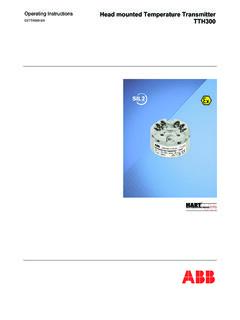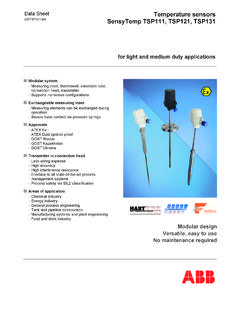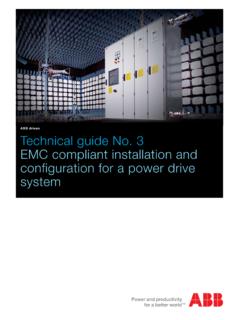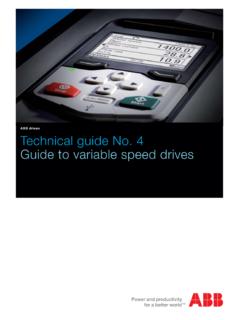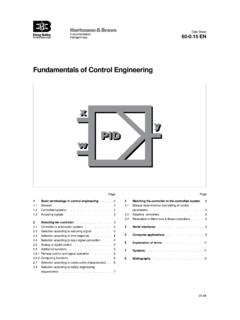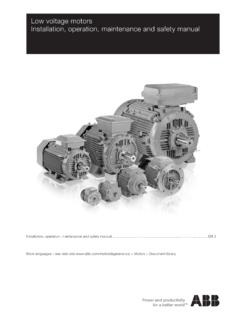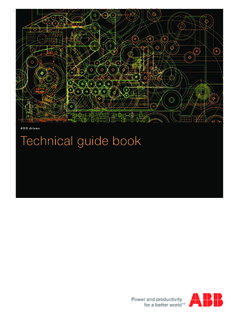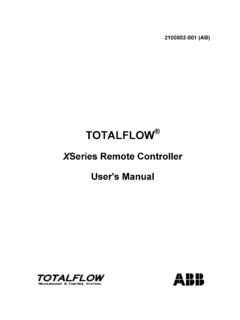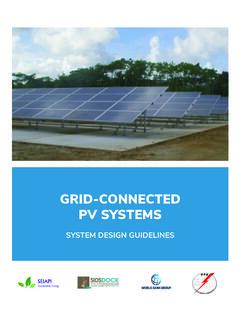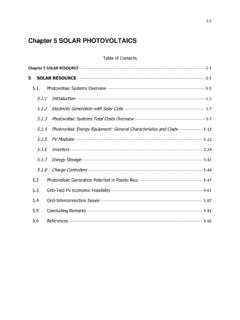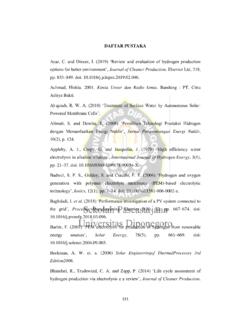Transcription of ABB circuit breakers for direct current applications
1 ABB circuit breakers for direct current applicationsLow Voltage Products & Systems 1 ABB Inc. 888-385-1221 1 SXU210206G0201 Index1. Introduction ..2 2. Generalities on direct current ..3 - 4 3. applications Conversion of alternative energies into electrical energy ..5 Electric traction ..7 Supply of emergency services or auxiliary services ..8 Particular industrial applications ..84. Generation Storage batteries ..9 Static conversion ..10 Dynamo ..115. Interrupting direct current ..12 - 136. Types of DC networks Network insulated from ground ..14 - 15 Network with one terminal grounded ..16 - 17 Network with the middle point of the supply source connected to ground ..18 - 197. Choice of the protective device ..20 - 308. Use of alternating current equipment in direct current Variation of the magnetic field ..31 - 32 Connection of circuit breaker poles in parallel ..339. ABB offering circuit breakers ..34 Molded case circuit breakers .
2 35 - 41 Annex A direct current distribution systems ..42 - 44 Annex B Calculation of short- circuit currents ..45 - 47 Annex CIEC circuit breakers and molded case switches for applications up to 1000 VDC ..48 - 51 Glossary ..522 Low Voltage Products & Systems 1 SXU210206G0201 ABB Inc. 888-385-1221 Introduction direct current , which was once the main means of distrib-uting electric power, is still widespread today in electrical plants supplying particular industrial advantages offered by the use of DC motors and sup-ply through a single line make direct current supply a good solution for railway and underground systems, trams, lifts and other transport means. In addition, direct current is used in conversion plants (in-stallations where different types of energy are converted into electrical direct energy, photovoltaic plants) and, above all, in those emergency applications where an auxiliary en-ergy source is required to supply essential services such as protection systems, emergency lighting, wards and facto-ries, alarm systems, computer centers, etc.
3 Accumulators are the most reliable energy source for these services, both directly as direct current as well as by means of uninterrupt-ible power supply units (UPS), where loads are supplied in alternating technical application paper is intended to explain the main aspects of the most important applications in direct current and to present the solutions offered by ABB prod-ucts. This paper also has the goal to give precise information to provide a rapid choice of the protection/disconnection device, paying particular attention to the installation charac-teristics (fault types, installation voltage, grounding arrange-ment).There are also some annexes with further information about direct current such as: Information about distribution systems Guidelines on the calculation of DC short circuit cur-rents as per IEEE 551, IEEE 141 circuit breakers and molded case switches for applica-tions up to 1000 VDCI ntroductionLow Voltage Products & Systems 3 ABB Inc. 888-385-1221 1 SXU210206G02012.
4 Generalities on direct current Knowing the electrical characteristics of direct current and its differences with alternating current is fundamental to understand how to employ direct definition, direct current has a unidirectional trend con-stant in time. Analyzing the motion of the charges at a point crossed by a direct current , the quantity of charge (Q) flow-ing through a cross section is always the same. Batteries or dynamos can provide direct current . It is also possible to convert alternating current into direct current through a rectifying , a pure direct current , a current which does not present any periodic fluctuation, is generated exclusively by batteries (or accumulators). In fact, the current produced by a dynamo can present small variations which do not make it constant in time. Nonetheless, from a practical point of view, this is considered a direct 1 Quantity of charge flowing through the cross section of a conductorIn a DC system respecting the current direction has a remarkable importance.
5 Therefore it is necessary to correctly connect the loads by respecting the termi-nals, as operation and safety problems could arise if the terminals should be connected example, if a DC motor were supplied by switch-ing the terminals, it would rotate in reverse and many electronic circuits could suffer irreversible on direct current4 Low Voltage Products & Systems 1 SXU210206G0201 ABB Inc. 888-385-1221 period10msI (A)t (ms)period20msI (A)t (ms) value of a sinusoidal quantityThe value is the parameter which relates alternating to direct value of an alternating current represents the direct current value that causes the same thermal effects in the same period of time. For example, a direct current of Figure 2 Periodic waveformFigure 3 value (value of the equivalent direct current )The value of a perfectly sinusoidal waveform is equal (where Imax is the maximum value of the amplitude of the sinusoidal waveform)Figure 4 Sinusoidal waveformFigure value (value of the equivalent direct current )1T i20T(t) (where T is the period)i (t)half period10msI (A)t (ms)period20msI (A)t (ms) A produces the same thermal effects of a sinusoidal alternating current with the maximum value of 141 A.
6 Thus the value allows alternating current to be treated as direct current where the instantaneous value varies in time. Generalities on direct currentLow Voltage Products & Systems 5 ABB Inc. 888-385-1221 1 SXU210206G02013. applications Low voltage direct current is used for different applications , which have been divided into four macrofamilies including: conversion into other forms of electrical energy (pho-tovoltaic plants, above all where accumulator batteries are used); electric traction (tram-lines, underground railways, etc.); supply of emergency or auxiliary services; particular industrial installations (electrolytic processes, etc.). Conversion of alternative energies into electri-cal energyPhotovoltaic plantsA photovoltaic plant converts the energy associated with solar irradiation into DC electrical energy. These plants are made up of semiconducting panels which can generate electrical power once exposed to the rays of the sun. photovoltaic plants can be grid-connected or supply a single load ( stand alone plant).
7 In this last case an accumu-lator battery is present to provide power in case of a lack of solar following figure shows a block diagram of a stand alone photovoltaic arraySingle moduleStringChargeregulatorDC loadAC loadDC/ACconverterBatteryApplicationsThe basic element of a photovoltaic plant is the photovoltaic cell made of semiconducting material (amorphous silicon or monocrystalline silicon). Exposed to the rays of the sun, this cell is able to supply a maximum current Impp at a maximum voltage Vmpp, which corresponds to a maximum power called Wp. photovoltaic cells are connected in series to form a string to raise the voltage level. By connecting several strings in parallel, the current level is increased. For example, if a single cell can provide 5A at VDC, in order to reach the level of 100A at 500 VDC, it is necessary to connect 20 strings in parallel, each one with 15 speaking, a stand alone photovoltaic plant in-cludes the following devices: photovoltaic array: photovoltaic cells suitably intercon-nected and used for the conversion of sunlight energy into electrical energy; Charge regulator: an electronic device able to regulate charging and discharging of accumulators; Accumulator batteries: to provide power supply in case of lack of solar radiation; DC/AC inverter: to turn direct current into alternating current by controlling it and stabilizing its frequency and Low Voltage Products & Systems 1 SXU210206G0201 ABB Inc.
8 888-385-1221 general diagram of a grid-connected photovoltaic plant, unlike a stand alone one, may leave out the accumu-lator battery since the user is supplied by the network when solar irradiation is unavailable. A photovoltaic plant of this type is made up of the following equipment: photovoltaic array: the photovoltaic cells suitably interconnected and used for the conversion of sunlight energy into electrical energy; DC/AC inverter: to turn direct current into alternating current by controlling it and stabilizing its frequency and waveform; Interface device: a circuit breaker equipped with an undervoltage release or a molded case switch able to guarantee the total separation of the power generation units from the public utility network; Energy meters: to measure and invoice the energy sup-plied and absorbed by the distribution following figure shows the block diagram of a grid-connected photovoltaic plants can supply currents from a few dozens of amperes (domestic applications and similar) up to several hundreds of amperes (service industry and small industry).
9 photovoltaic arraySingle moduleStringUser sloadsDC/ACinverterkWhkWhMeter ofthe givenenergyMeter of theabsorbedenergyTo thedistributionnetworkInterfacedeviceApp licationsLow Voltage Products & Systems 7 ABB Inc. 888-385-1221 Electric tractionThe particular torque/speed characteristic curve and the ease with which the speed itself can be regulated have led to the use of DC motors for electric current supply also gives the great advantage of hav-ing the contact line consisting of a single conductor as the rails provide the return , direct current is used primarily in urban transport like trolleybuses, trams and underground railways, with a supply voltage of 600 V or 750 V, up to 1000 use of direct current is not limited only to vehicle traction. direct current represents a supply source for the auxiliary circuits on board vehicles as well. In this case, ac-cumulator batteries are installed and constitute an auxiliary power supply source to be used if the external power sup-ply should is very important that this power supply be guaranteed since the auxiliary circuits may supply essential services such as air conditioning plants, internal and external light-ing circuits, emergency brake systems or electrical heating applications of circuit breakers in DC circuits for electric traction can be summarized as follows: Protection and operation of both overhead and rail con-tact lines; Protection of air compressors on board subway and train cars; Protection of distribution plants for services and signal-ing systems; Protection of DC supply sources (accumulator batter-ies) Protection and operation of DC Low Voltage Products & Systems 1 SXU210206G0201 ABB Inc.
10 888-385-1221 the Supply of emergency services or auxiliary services direct current is used (directly or indirectly through accumu-lator batteries) in those plants for which service continuity is that cannot tolerate a power failure caused by a loss of energy need a ready-to-use supply source which is able to cover the time needed to start an emergency generating are some examples of this type of user plant: industrial applications (process control systems); safety and emergency installations (lighting, alarms); hospital applications ; telecommunication; applications in the data processing field (data centers, work stations, servers, etc.).In these installations energy interruptions cannot be permit-ted. Therefore it is necessary to include systems to store energy when supplied that can give it back immediately if power batteries are the most reliable electric energy source for the supply of such services, both directly in direct current (if allowed by the loads) as well as in alternating current by using an inverter able to develop an outgoing sinusoidal waveform starting from an incoming continuous above is carried out by uninterruptible power supply units (UPS):Figure 6 Principle diagram of a Particular industrial applications The use of direct current is often required in many industrial applications such as: arc furnaces; electro welding plants; graphite manufacturing plants; metal production and refining plants (aluminum, zinc, etc.)
